Children have tended to be represented in art either as miniature versions of adults or icons of innocence. What artists have failed to capture is the transient nature of childhood and all the vulnerabilities inherent in it. The work of one artist working in Scotland after WWII is highlighted – Hermann Gross. For 25 years he was artist-in-residence in a residential child care setting in Aberdeen. What is striking about Gross’s work is the way in which it addresses some of the dilemmas faced by staff in their dealings with the children in their care. What is not in doubt is that for many residential care staff, Gross’s paintings helped shape and colour their perceptions of the nature of their work and give meaning and purpose to it. He succeeded in different ways in capturing some of the quintessential features of childhood which now appear to be under threat. His work is important because it provides us with a timely reminder of the precious nature of childhood and what we, as a society, appear to be in danger of losing.
Anne Higonnet has described the evolution of pictures of children from little adults to unadulterated innocence and suggests that artists and viewers alike bring certain predispositions to the work. Until the mid-eighteenth century, the notion of children as faulty small adults, in need of correction and discipline, prevailed. Children appeared in pictures as miniature versions of the grown-ups they were to become. They dressed and gestured as adults, which also demonstrated their respective stations in life. Van Dyck’s 1635 portrait of George Villiers, 2nd Duke of Buckingham, and his brother, Lord Francis Villiers, depicts two figures dressed in adult-styled clothing sized to fit their small bodies. Their stiff poses – hands on hips, toes turned out, one leg extended forward – convey the masculinity and authority of their older male relations, traits the boys soon would grow into. The portrait suggests affluence and power, not childhood sweetness (Higonnet, 1998). Around the period of the Enlightenment in the eighteenth century, popular conceptions of childhood changed. The “Romantic child” was born. Romantic children, claims Higonnet, “deny, or enable us to forget, many aspects of adult society. The Romantic child makes a good show of having no class, no gender, and no thoughts...of being socially, sexually and psychically innocent,” (Higonnet, 1998: 23-24). In contrast to the Villiers portraits, the representation of Penelope Boothby (1788) by Joshua Reynolds does not exert power. She sits meekly with her hands gently clasped. Her dress and hat mimic adult styles but the size of the clothing compared to her diminutive face identifies Penelope as a child playing grown-up. No longer considered little adults in need of moral reform, children become icons of innocence and naivet” onto which adults could project their own hopes, dreams and ideals. Paintings and sculptures of socially ignorant, asexual children dominated the art world, and the “Romantic child” became the accepted standard. The Villiers boys stand in a dignified manner that indicates power and aggression. Paintings of Romantic children, on the other hand, concentrated on aspects of the body least closely associated with adult sexuality (Higonnet, 1998).
The challenge for the artist is to be able to convey to the viewer the transient nature of childhood and all the vulnerabilities inherent in it without recourse to the cloyingly sentimental images that characterised much of Victorian illustrations depicting childhood. For the childhood portrayed at that time was in large measure a bogus one. Many of the children who appear closely and lovingly ensconced in the bosom of a devoted family were either in the care of a governess or attending a distant boarding school. There was also a tendency to represent children as innocent, angelic, appealing, attractive, obedient and gentle beings, whereas by nature they are, for at least some of the time, mischievous, naughty, unappealing, unattractive, wayward and wild. As Deborah Knight notes, sentimentality in art makes no demands upon us, requires no struggle, involves only a narrow range of feelings, arouses no thoughts or feelings about the real world: it represents a general failure of imagination (Knight, 1999).
Where artists have taken children as legitimate subjects for paintings, their work has tended to be criticised as sentimental. This was a judgement of some critics of the work of Joan Eardley who painted the children who lived in the decaying tenement districts of post-war Glasgow. Adult figures very rarely appeared in her work. Eardley’s work may only have gained critical acceptance once it was realised that she was not a purveyor of kitsch. Eric Newton, the art critic of The Guardian, in a review of the last Joan Eardley exhibition in London in 1963 commented: “only in an occasional Goya do I remember the translation of small children into paint mixed so inseparably with warm-hearted self-identification with the inner life of the child” (Newton, 1963).
Eardley’s paintings demonstrate that, notwithstanding personal circumstance, the child possesses an inner resilience that transcends that circumstance, however disadvantageous. She was particularly attracted by the friendliness and community spirit to be found in these decaying districts: a quality that Ralph Glasser highlighted in his autobiography Growing Up in the Gorbals (Glasser, 1987). The childhood images speak strongly of kinship, with hands held, arms thrown around shoulders and direct gazes. Fiona Pearson has observed that this sense of kinship between the figures is one of the most striking features of Eardley’s paintings of children. A significant background feature in many of Eardley’s pictures is the graffiti. The graffiti is significant because not only does it mark out territorial boundaries, but also helps to confer a sense of community identity on those living within particular districts. An intriguing feature in the representation of the graffiti is that in a number of the pictures it forms part of a collage which includes torn extracts from newspapers. These newspaper scraps present a powerful visual metaphor in that – like Eardley’s pictures – they are fragmentary records of a time that has passed.
Given the cramped and overcrowded character of tenement accommodation, children spent a great deal of their time playing in the tenement closes and adjoining streets in the company of their friends. Games feature strongly in Eardley’s pictures. Whilst it may be tempting to characterise children's play as anarchic, most games would have been governed by rules which it was expected that participants would abide by without the necessity of intervention from or arbitration by adults. So the kind of children's street culture that Eardley was depicting was invented and sustained by the children themselves without any adult involvement. Also an urban area that might appear featureless and neglected to an adult may have had deep “spirit of place” meanings within the children's street culture. There is an element of nostalgia in Eardley’s pictures because she must have known she was looking at a culture that was nearing extinction. Eardley was able to capture some of the quintessential features of childhood which today appear under threat given the advent of such distractions as video games, the internet and television which are targeted at the individual child.
Some commentators may feel that Eardley was guilty of presenting an unduly romanticised view of life in the inner city. However she would have been fully aware, having lived herself in the Gorbals, of the acute level of material deprivation experienced by most families. Eardley was witnessing the enforced transfer of families from their homes to accommodation on outlying housing estates where the material conditions would initially have been infinitely superior. But the point that Eardley appears to be making is that the quality of life of the children and their parents cannot be simply judged by improvements in the material conditions. More important is that people have a sense of belonging and well-being. The fact is that the dispersal of residents to these estates frequently led to families being separated and social networks fragmented. In the process something had been irretrievably lost.
Hermann Gross
1963, which saw the death of Joan Eardley, saw the arrival in Scotland
from Germany of Hermann Gross. He had been invited by Dr Karl Koenig,
the co-founder of the Camphill Movement, to come to the Camphill
community – a residential child care setting – in Aberdeen to act as
artist-in-residence. Gross who had been born in 1904 had been taught by
a succession of distinguished artists in Germany and France including,
Haustein, Raemisch, Wlrick and Picasso. During the war he served as a
war artist and was based in Paris before being transferred to the
Eastern Front. After the war he emigrated to the USA but returned to
Germany after eight years. Gross was aware of the fact that moving to
Scotland would mean abandoning home and friends, beginning a new life in
a strange country at an age when most people could not bear to be
uprooted. It was above all a deep spiritual decision on his part that he
would live for art rather than from it.
Gross’s move to Scotland is not altogether surprising, for Dr Koenig and Gross would have shared a common language both recognising and valuing the spiritual dimension in art and both seeking ways to give artistic expression to the human spirit. They would also have been aware of the fact that modern art had been profoundly influenced by the writings of Rudolf Steiner. Kandinsky in Concerning the Spiritual in Art refers to Steiner’s interest in providing alternative means of spiritual communication given that religion had been so fundamentally questioned (Kandinsky, 1977). Kandinsky was particularly concerned in making contact with what lay beneath the surface and the inner feelings of the spectator. Steiner contended that it was possible to encounter this divine or spiritual dimension behind the world of appearances.
When Gross was artist in residence, a significant number of children attending the Camphill School were drawn from the same districts in Glasgow with which Eardley would have been familiar. Thus there is a sense in which both Gross and Eardley were portraying children from identical backgrounds. One might argue that Eardley and Gross differ in one important respect: Eardley tended to focus almost exclusively on the child, whereas Gross almost always sets the child in the context of a relationship with one or more adults. However both Eardley and Gross highlighted the importance of interdependence – an essential feature of life in a Camphill community. The life-sharing aspect of Camphill community life is one of its defining features, as this ensures that the principles of dignity and mutual respect can be meaningfully translated into practice. And it is this mutual relationship that provides the cohesive force that binds together the different elements of a community: it is the mortar without which the communal edifice would collapse.
What is striking about Gross’s work is the way in which it addresses some of the dilemmas faced by staff in their dealings with the children in their care. He was able to identify with many of these often severely traumatised and bewildered children as a result of his experiences during the war when – as a German conscript – he was engaged in the savage and fierce fighting on the Russian front. He never fully recovered from this experience and something of this continuing inner turmoil can be found in his paintings. But what I hope to demonstrate is that in his paintings Gross was able nonetheless to communicate a strong, positive and life-affirming message to those working on a daily basis with the children in their care. What I also hope to show through a discussion of seven of Gross’s paintings is that art can be an effective medium for conveying complex ideas about the nature of childhood and for suggesting ways of nurturing and caring for vulnerable children. In other words, it is possible to have art which is illuminating but not didactic. The following descriptions are drawn from a recent biography of Gross written by the author (Jackson, 2008).
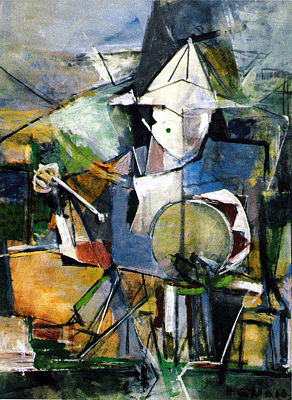
An important feature of Camphill life is illustrated in Plate 1. In attempting to communicate effectively with a child, the carer has to fall into step with the child, so that they “dance to the same tune.” It is necessary, therefore, to listen to the “beat” that the child provides. The child and the carer then search for ways to establish and maintain that joint rhythm, in a mutually inclusive way. It is necessary to learn to listen, to look, and explore in a new way, the pulse of groups with whom one works. Rhythm is crucially important for it provides an impulse and framework that enables often bewildered and disoriented children to experience for the first time a measure of stability, security and predictability. Rhythm is the living pulse that sustains the work of a community. But the binding qualities of rhythm must not be confused with the lockstep quality of the single drummer’s efforts to gain conformity. True rhythmicity, in contrast, requires a process of mutual engagement and inclusion, a response to the beat of several drummers.
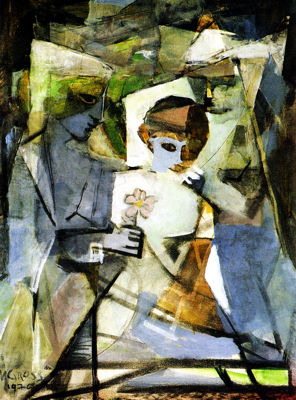
The dominant feature in Plate 2 is the eye of the child looking out at and inviting the viewer into the picture. The subdued tones of the palette used in this painting convey an impression of a tender and caring relationship between the child and the two adults – possibly nurses – who stand on either side of him. There is no mawkish sentimentality in this relationship. The painting successfully encapsulates the essence of Camphill philosophy and practice, where the child is placed at the centre of its work. Gross’s experience of living in a community dedicated to the care of vulnerable children and young people enabled him to communicate in a direct way the tender and supportive character of the adult-child relationship.
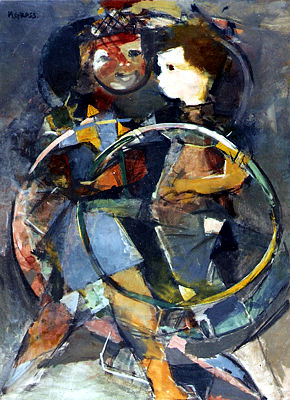
In Plate 3, which shows two children playing, Gross may be wishing to remind adult viewers in the Camphill community of the importance of play in a child's life, a point highlighted in Eardley’s pictures. It is not an incidental and trivial activity engaged in by a child, but an important part of a child's physical, social and moral development. Play is the natural way for children to make sense of, and internalise, a whole range of experiences. It offers the opportunity to explore ways of being, of establishing identity and building self-esteem. The way in which the children's bodies intersect geometrically may be intended to convey the importance of social interaction, while the rings give an impression of vigorous movement. The smile on the face of the child wearing the tartan bonnet is perhaps a reminder that play is intended as an enjoyable experience. The content of this painting has a strong contemporary relevance. Play, whether formalised within the context of games, or recreational activities, or stemming from the creative imagination of the individual child, appears to have no place in the present day mainstream curriculum. The consequence is educational, cultural and social impoverishment. But as Gross recognised, an individual’s spiritual development is dependent upon opportunities for free and creative self-expression.
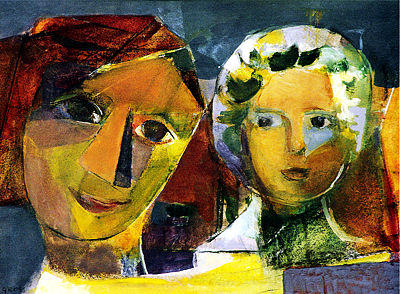
In Plate 4 we have the juxtaposition of the angular mask-like face of the woman with the more realistically portrayed face of the child. What is Gross seeking to communicate to the viewer? Is he suggesting that in the presence of children adults tend to conceal their identity behind a mask dictated by the pressure of social conventions? The child appears to be slightly behind the woman and looking questioningly at her. Children often find the behaviour of adults difficult to comprehend. Essentially, this painting was intended to be seen by adults in a residential childcare setting. Is Gross intimating that the care offered by the adult has to be genuine and unconditional and not feigned “not least because most children are sophisticated enough to make that distinction? Whilst adults may attempt to hide behind a mask, children can frequently see through it.
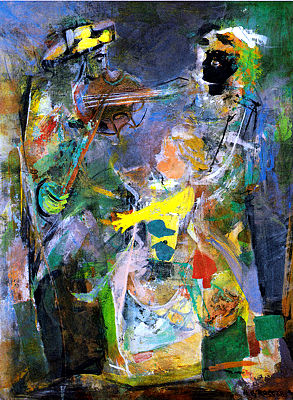
In Plate 5 we have a young child sitting on a rocking horse who is accompanied by a person with a blackened face or mask. Is this an allusion to Kaspar Hauser – a figure of mystery whose life is celebrated in Camphill communities? Kaspar was a child who lived in a tiny cave somewhere in the German countryside without any human contact except for a mysterious masked man who appeared from time to time to give him food. His only company was a rocking horse. Kaspar, who eventually learned to speak, read and write in a rudimentary way, had an obsession in asking people simple questions that they could not answer and which made them feel uncomfortable. A major difficulty for Kaspar was that he could not understand the basic dynamics of human relationships, thus ending up in a state of social limbo. What is interesting about Kaspar is that he possessed many of the characteristics of someone on the autistic spectrum, in particular his inability to decode the social rules that govern interpersonal conduct. And yet that difficulty has a value because it means that social behaviour that we take for granted as normal is challenged. The autistic child has an innocence not possessed by others, and it is this innocence that makes non-autistic people uncomfortable. It is believed that Kaspar came from a noble family in Baden, but one that wanted to distance themselves from the attendant stigma of it being known that they had a handicapped family member. What is not clear is the role of the fiddler in this painting. Given that this painting is targeted at staff in Camphill, Gross may be making the point that one effective way of communicating with autistic children is through music. There is within the structure and rhythmic patterns of music a language to which many autistic children can relate. Another way of interpreting this painting is that if staff exercise their imagination and undertake a conscientious search, they will find some way of communicating. In the 1960s, when this picture was painted, this would have been a revolutionary notion.
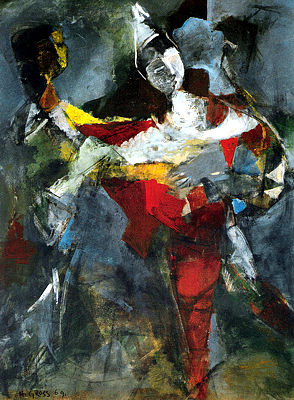
We are presented in Plate 6 with a figure cradling a baby in his left arm and holding a mask in his right hand. A curious feature of the mask is that it is not a conventional facemask but rather the kind of all-enclosing hollow iron mask worn by prisoners in centuries past. The red, yellow and black diamond pattern of the costume, when coupled with the cross-gartered red hose, seem to point to the figure being Harlequin; yet the whitened face, the conical white hat and the gloved hands suggest Pierrot! So who is actually portrayed here? What is the significance of this ambiguity and ambivalence? When we think of Harlequin and Pierrot, we tend to associate certain distinctive characteristics with each one. Is Gross encouraging the viewer not to prejudge people by their outward appearance? In other words, the more closely we look, the more likely it is that we will find in people unexpected facets that run counter to our expectations. The use of strong primary colours coupled with the free and expressive manner in which the paint has been applied make a strong and disconcerting visual impact. It is unsettling not simply because of the subject matter, but because of the way in which the composition has been structured. The arrangement of the legs of the central figure indicates that he is in a state of disequilibrium.
What is particularly disquieting is the apparent threat that the mask held by the central figure may be placed over the child's head. The sight of a potentially suffocating mask approaching the head of an innocent and vulnerable child is disturbing. Gross may be alluding to the fact that all children, if they are to cope with all that life has to throw at them, need the time and freedom to develop a clear sense of who they are. A significant number of children, attending the School in the 1960s, came from family backgrounds characterised by acute psychological and social deprivation, in which they had failed to develop a clear sense of identity. Thus the carers had the responsibility of looking after and responding to children who were not simply bewildered and angry at the world at large, but also suspicious and frightened of adults. The message for carers is that they needed to offer the child constancy of affection, consistency in approach and unwavering commitment, notwithstanding their outward “appearance”.
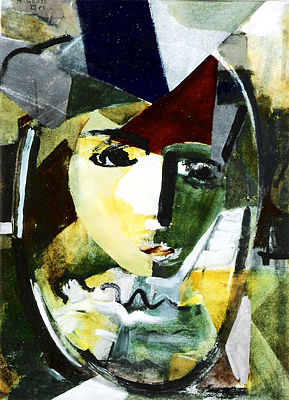
In Plate 7 we have a reflection of a face in a mirror. The ruff at the neck strongly suggests a favourite subject for a number of Post-Impressionists painters. Is this Pierrot looking into the mirror and out at the viewer? What the viewer is therefore seeing is not the face of Pierrot, but his reflection, which is not the same thing. In this instance no mask is required to conceal identity. As with Edouard Manet’s The Bar at the Folies Bergeres (1881/2), mirrors can be employed to explore the idea that appearances can be deceptive, and pose the question of whether we can ever see things as they really are.
Some reflections
In the immediate aftermath of the war Gross’s paintings were explicitly
religious in content and were acknowledged by him to represent a working
out of his own inner emotional and spiritual turmoil. In that respect
they were classic examples of German Expressionist art. With the passage
of time and particularly from the moment he assumed the role of
artist-in-residence in Camphill, the character of his work underwent a
significant change. The two themes of “masks and masquerades” and “children in care”, which feature in Gross’s work, pose questions about
identity and mission: “Who am I?” and “What is my purpose?” It is
difficult to think of two more fundamental questions for anyone to
consider. However, long before the notion of “the reflective
practitioner” became part of common professional parlance, Camphill
co-workers had been constantly encouraged to engage in professional
reappraisal and spiritual reflection. Thus, they were likely to be
attuned to the fact that Gross was seeking to communicate with them.
Whilst Gross may have had a target audience in mind, the content of his
paintings has a universal relevance and value. It needs to be remembered
that these paintings were not hanging in an art gallery but were located
throughout the Community and were thus visually accessible.
It is not without significance that Camphill communities have been characterised as possessing many of the characteristics of a lay religious order (McKanan, 2007). What Gross did was follow a well established path. For centuries painters had created work for churches, monasteries and convents; initially the paintings depicted were simple and uncomplicated iconic subjects such as Christ and The Virgin Mary. However in the 15th century Jan van Eyck and Rogier van der Weyden, two masters of Northern Renaissance art, began to communicate hidden messages in their religious paintings, which if spoken or written would have been viewed as subversive or even heretical. Through their art they were able to allude to the serious failings in the all-powerful Catholic Church that Martin Luther was much later openly to condemn. This was a risky business because their livelihood depended entirely on church patronage. Nevertheless there was an expectation on the part of van Eyck and van der Weyden that viewers would seek the coded references embedded in their paintings. Gross, for his part, was quite clear that the viewer had to work to find the meaning. The fact that his paintings were hung in halls, committee rooms, and residences throughout the residential care setting meant that people were daily confronted with them. They were unavoidable. What is not in doubt is that for many residential care staff, Gross’s paintings helped shape and colour their perceptions of the nature of their work and give meaning and purpose to it (Jackson, 2008).
It would be a mistake to think that the message that Gross was communicating has meaning only for those living and working in Camphill. Alice Louchheim, the doyenne of New York art critics, noted in 1951 that Gross was not only a true descendant of the German Expressionist School but also someone who used that art form to communicate a powerful spiritual message which was relevant to contemporary society. The fact that Gross’s work remains largely unknown is because he chose to forsake the conventional path taken by artists by not publicly exhibiting his work.
Conclusion
The work of Hermann Gross is significant because it focuses on a
neglected subject in art. He succeeds in different ways in capturing
some of the quintessential features of childhood which now appear under
threat. For example, opportunities for unsupervised play and recreation
are limited by the growth of a risk-averse culture which tends to
extinguish spontaneity, creativity and enjoyment. At school children are
increasingly subject to a utilitarian approach to education which
emphasises the acquisition of certain basic skills and which attaches
little value to seeking ways of enhancing a child's physical, social and
spiritual well-being. Children also represent an extremely lucrative
target for the omnipotent and omnipresent marketing industry which, for
commercial reasons, quite deliberately exploits their susceptibilities.
Childhood is then under attack from different quarters. A recent report
has indicated that the state of childhood which is a recurring topic of
our times is “under threat” or “disappearing” (Children's Society,
2006). New comparative research of children's well-being in the European
Union, found that the UK is faring exceptionally badly. Amongst the rich
western member states, the UK ranked lowest (Bradshaw et al., 2007)! The
significance of Gross’s work, which is sometimes subversive, often
provocative and always instructive, is that it illustrates the value of
art as a way of communicating profound insights about the nature of
childhood to those charged with the awesome responsibility of caring for
children and young people. It also provides us with a timely reminder of
the precious nature of childhood and what we, as a society, may be in
danger of losing.
References
Bradshaw, J., Hoelscher, P. & Richardson, D. (2007) An index of child well-being in the European Union, Journal of Social Indicators Research, 80. pp. 133–177.
Children's Society. (2006) Good Childhood? A Question for our Times. A Summary Report, London.
Glasser, R. (1987) Growing Up in the Gorbals. London: Black & White Publishing.
Higonnet, A. (1998) Picturing Innocence: The History and Crisis of Ideal Childhood. New York: Thames & Hudson.
Jackson, R. (2008) Hermann Gross: Art and Soul. Edinburgh: Floris Books.
Kandinsky, W. (1977) Concerning the Spiritual in Art. New York: Dover Publications.
Knight, D. (1999) Why we enjoy condemning sentimentality: a meta-aesthetic perspective, The Journal of Aesthetics and Art Criticism, 57, 4. pp. 411–420.
McKanan, D. (2007) Touching the World: Christian communities transforming society. Minnesota: Liturgical Press.
Newton, E. (1963) The Guardian 29 June 1963.
Pearson, F. (2007) Joan Eardley. National Galleries of Scotland, Edinburgh.
For more information about the work of Hermann Gross see Hermann Gross: Art and Soul (2008) by Robin Jackson published by Floris Books of Edinburgh.
Robin Jackson has been a consultant to Camphill School Aberdeen for the past eight years. He has a PhD in Education awarded by the University of Exeter. He has held a variety of posts in the disability field: Principal of Linn Moor School, Aberdeen; Principal Lecturer in Special Education, King Alfred's College, Winchester; Co-ordinator for the South Aberdeen- shire Advocacy Service ; and Development and Training Co-ordinator, Camphill Scotland. He has written extensively in the field of intellectual disability.
This feature is co-published as: Jackson, R. (2009). Representation of children in art: Hermann Gross. Relational Child and Youth Care Practice, 22,3. pp. 20-28.